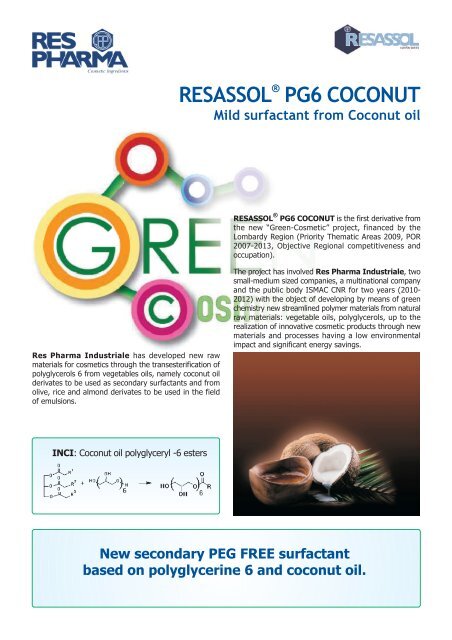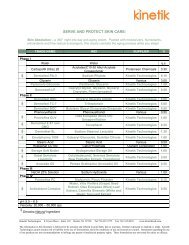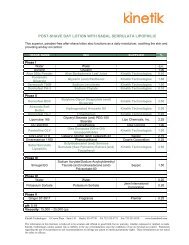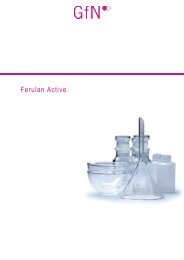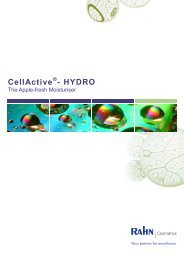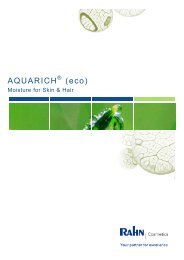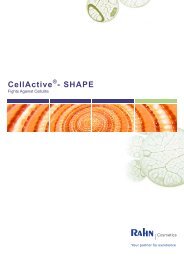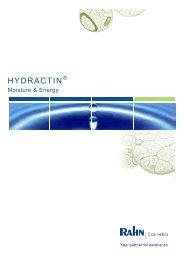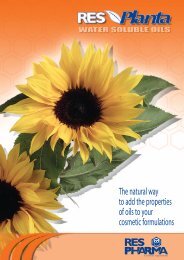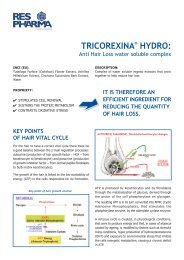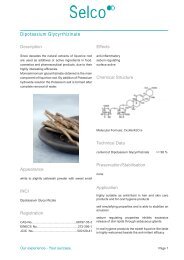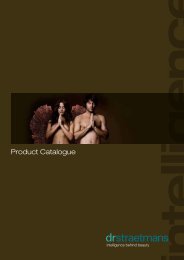Resassol PG-6 Coconut Marketing Sheet - Kinetik
Resassol PG-6 Coconut Marketing Sheet - Kinetik
Resassol PG-6 Coconut Marketing Sheet - Kinetik
You also want an ePaper? Increase the reach of your titles
YUMPU automatically turns print PDFs into web optimized ePapers that Google loves.
RESASSOL ® <strong>PG</strong>6 COCONUT<br />
Mild surfactant from <strong>Coconut</strong> oil<br />
RESASSOL ® <strong>PG</strong>6 COCONUT is the first derivative from<br />
the new “Green-Cosmetic” project, financed by the<br />
Lombardy Region (Priority Thematic Areas 2009, POR<br />
2007-2013, Objective Regional competitiveness and<br />
occupation).<br />
Res Pharma Industriale has developed new raw<br />
materials for cosmetics through the transesterification of<br />
polyglycerols 6 from vegetables oils, namely coconut oil<br />
derivates to be used as secondary surfactants and from<br />
olive, rice and almond derivates to be used in the field<br />
of emulsions.<br />
The project has involved Res Pharma Industriale, two<br />
small-medium sized companies, a multinational company<br />
and the public body ISMAC CNR for two years (2010-<br />
2012) with the object of developing by means of green<br />
chemistry new streamlined polymer materials from natural<br />
raw materials: vegetable oils, polyglycerols, up to the<br />
realization of innovative cosmetic products through new<br />
materials and processes having a low environmental<br />
impact and significant energy savings.<br />
INCI: <strong>Coconut</strong> oil polyglyceryl -6 esters<br />
New secondary PEG FREE surfactant<br />
based on polyglycerine 6 and coconut oil.
% Inhibition<br />
IN VITRO TEST<br />
The toxicity of surfactants is determined by their capacity to degrade lipids, as the membrane of eukaryotic cells is mainly<br />
composed of lipids they are particularly sensitive to their “degreasing” action.<br />
The permeabilization of the membranes deriving from the use of surfactants determines, initially, the diffusion to the outside<br />
of some cytoplasmic solutes among which the Lactate Dehydrogenase enzyme (LDH) and, subsequently, the death of the<br />
cells.<br />
(The release of LDH in the culture medium is considered an early marker of toxicity because it is possible to find it at the<br />
beginning of the lesion several hours before the death of the cells).<br />
The test was performed on human keratinocytes which represent the first barrier against external aggression, and which<br />
are therefore the first to counter the effects of the surface-acting agents also In Vivo. The cells were exposed to contact<br />
with a solution containing RESASSOL ® <strong>PG</strong>6 COCONUT at 0.04% and SLES at 0.003% for periods of 60-120 and 180<br />
minutes.<br />
At each interval an assay of the LDH released was carried out, the internal check is represented by an identical solution<br />
of SLES 0.003% containing 0.01% of Betaine, the positive check is represented by the solution of SLES at 0.003%.<br />
At the end of the last incubation of 180 minutes the treatments were removed and replaced with normal culture medium<br />
for a recovery period of 22-24 hours (to check whether the lesions inflicted by the treatment were capable of causing the<br />
death of the cells or not: in other words in this way we also checked the seriousness of the lesions suffered by the cells<br />
regardless of the quantity of LDH released).<br />
PERMEABILIZATION OF MEMBRANES<br />
INHIBITION RELEASE OF LDH<br />
RESASSOL <strong>PG</strong>6 COCONUT<br />
The results show how the presence of the coconut and<br />
polyglycerol derivate is capable of increasing the dermocompatibility<br />
of the SLES solution; actually, it stops the<br />
release of LDH within the first 120 minutes of exposure and<br />
it reduces it by 93% after 180 minutes. The comparison<br />
with Betaine brings out even more the effectiveness of the<br />
product; indeed, even though it too is capable of reducing<br />
considerably the release of the enzyme after 60 and 120<br />
minutes of treatment, after 180 minutes its action is limited<br />
to inhibiting release of LDH only by 48%.<br />
The results obtained reveal an excellent detoxifying<br />
action of the coconut and polyglycerol derivates with<br />
the SLES solution and therefore a strong capability<br />
of the product to increase the dermo-compatibility<br />
of primary surfactants.<br />
RESASSOL <strong>PG</strong>6 COCONUT<br />
% VITALITY<br />
RESASSOL <strong>PG</strong>6 COCONUT<br />
POST RECOVERY VITALITY<br />
The results obtained reveal how both polyglycerols and<br />
betaine have reduced the toxicity of the SLES solution:<br />
Indeed, both allowed a survival level around 100%, while<br />
the cells exposed to SLES only show a vitality of 27%.<br />
Polyglycerols have shown to have a better detoxifying action<br />
considering that, against a survival rate practically equal<br />
to that of betaine, it determines a definitely lower release<br />
of LDH at 180 minutes. The LDH is only one of the proinflammatory<br />
mediators that are released during the<br />
inflammatory reactions typical of an irritation, which can<br />
appear also in the absence of cell death and/or necrosis;<br />
consequently we can say that polyglycerols have a<br />
higher dermo-compatibility and detoxifying action<br />
than betaine has.<br />
RESASSOL<br />
% VITALITY
PHOTOGRAPHS AFTER RECOVERY (MTT)<br />
Pictures show an high mortality of cells<br />
exposed to the SLES solution ( Image 1 ).<br />
On the contrary, the % of survival remarkably<br />
increases for cells exposed to the solution<br />
RESASSOL ® <strong>PG</strong>6 COCONUT+SLES (<br />
Image 4 ) and BETAINE+SLES ( Image 3).<br />
Notwithstanding both samples set to zero<br />
the % of cell mortality ( vitality experiment),<br />
cells treated with BETAINE+SLES are more<br />
suffering even if alive.<br />
Fig.1: Negative check (4x) Fig.2: RESASSOL® <strong>PG</strong>6 COCONUT 0.04%<br />
+SLES 0.003% (4x)<br />
These results confirm the results of the<br />
permeabilization of membranes: treatment<br />
with BETAINE does not set to zero the<br />
release of LDH at 180 minutes of exposition;<br />
BETAINE cannot buffer with the same<br />
efficiency the solution of SLES which,<br />
damaging the membranes, compromise the<br />
wellness of treated cells.<br />
RESASSOL ® <strong>PG</strong>6 COCONUT gives the<br />
best result in terms of increasing the<br />
dermo-compatibility of the SLES<br />
solution.<br />
Fig.3: Betaine 0.01%+SLES 0.003% (4x)<br />
Fig.4: Positive check, SLES 0.003% (4x)<br />
APPLICATION STUDIES<br />
From studies performed both on SLES and SLES FREE surfactant systems, we are able to say that RESASSOL ® <strong>PG</strong>6 COCONUT<br />
increases foam height and persistence, enriching the formulation with the emollient properties deriving from the starting oil.<br />
FOAM HEIGHT<br />
Foam height of a mixture containing increasing concentration of RESASSOL ® <strong>PG</strong>6 COCONUT in solution with different primary<br />
surfactants has been evaluated during the time.<br />
+RESASSOL <strong>PG</strong>6 COCONUT 3%<br />
+RESASSOL <strong>PG</strong>6 COCONUT 6%<br />
+RESASSOL <strong>PG</strong>6 COCONUT 3%<br />
+RESASSOL <strong>PG</strong>6 COCONUT 6%<br />
+RESASSOL <strong>PG</strong>6 COCONUT 3%<br />
+RESASSOL <strong>PG</strong>6 COCONUT 6%<br />
In blends with SLES, the RESASSOL ® <strong>PG</strong>6 COCONUT shows that it improves the foam height with concentrations<br />
above 6%. In particular, it keeps consistency and permanence in time. It was also added to other non<br />
ethoxylated primary surfactants, confirming its capacity to increase and stabilize foam.
With these last surfactants, its effectiveness is revealed at lower<br />
concentrations compared to the combinations with SLES ( 3%).<br />
RESASSOL <strong>PG</strong>6 COCONUT Vs Betaine<br />
The graph here below even shows that when associated with<br />
the Caprylyl/Capryl Glucoside system it is more efficient as a<br />
foam stabilizer than the betaine system.<br />
RESASSOL <strong>PG</strong>6 COCONUT 3%<br />
200ml demineralized water is added to 1% of surfactant mixtures.<br />
10 Pistons hits - diameter 5.5 cm - number of holes: 26 (diameter 0.4 cm)<br />
APPLICATIONS<br />
Recommended for mild formulations, specific for different<br />
ages (baby, senior) and applications on delicate areas<br />
(Intimate hygiene, products for scalp).<br />
TOXICOLOGICAL DATA<br />
Test in Vitro Ocular Irritection ® : Mild irritant<br />
Test in Vitro Dermal Irritection ® : Not irritant<br />
70400_eng<br />
The data provided in this publication is based on our current<br />
knowledge and experience and is offered free of charge and<br />
in good faith for guidance only. It does not constitute a<br />
guarantee in the legal sense of the term and in view of the<br />
multiple factors that may affect processing and applications,<br />
it does not relieve those to whom we supply our products<br />
from the responsibility of carrying out their own tests and<br />
experiments. All express and implied warranties are disclaimed.<br />
Any relevant patent rights and existing legislations and<br />
regulations must be observed.<br />
www.respharma.com<br />
Res Pharma s.r.l.<br />
Via Giulio Pastore, 3 - Trezzo sull'Adda (MI) Italia<br />
Tel. 02.909941 - Fax. 02.90963944<br />
E-mail: info@respharma.com<br />
Register to get access to complete<br />
technical documentation and formula<br />
examples by Centro Tecnico Res Pharma


